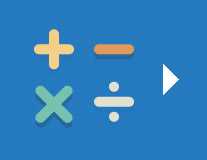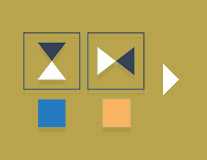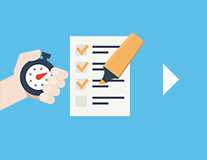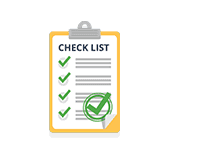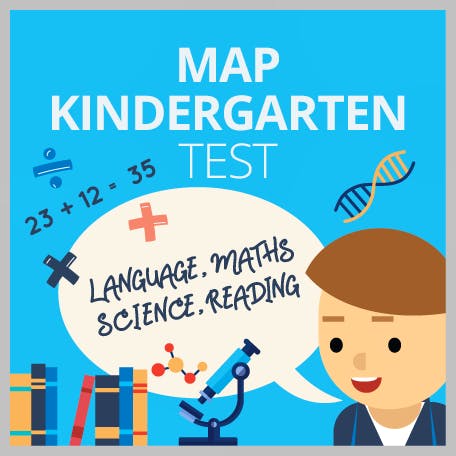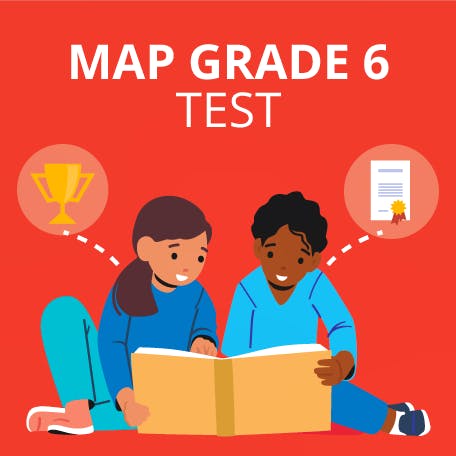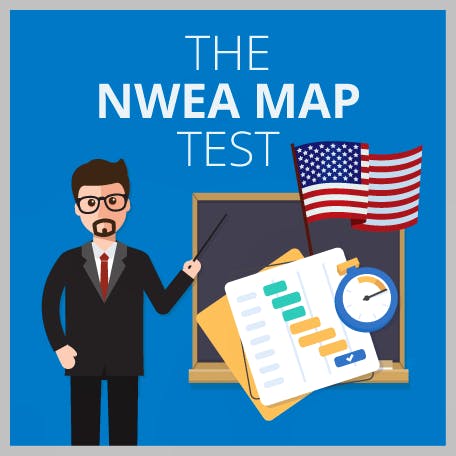Map Test Grade 7: Full Guide
Updated November 3, 2024
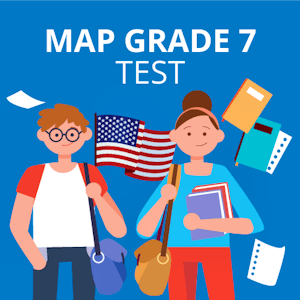
- MAP Grade 7 Sample Question
- What Are MAP Tests?
empty
- The MAP Test 7th Grade: The Format
empty
empty
empty
- Sections of the MAP Test 7th Grade
- The Topics in the MAP 7th Grade Test
empty
empty
empty
- MAP Test Practice 7th Grade Example Questions
empty
empty
empty
- NWEA Practice Test 7th Grade Tips
- Frequently Asked Questions
- Final Thoughts

The MAP Test Grade 7 tests students’ proficiency in mathematics, reading and language usage.
Developed by the Northwest Evaluation Association (NWEA), it measures individual growth over time, adapting question difficulty based on responses.
This online test lasts around two to three hours, and the results are used to inform teaching or gauge students' ability levels.
Scoring is based on the RIT (Rasch Unit) scale, indicating a student's instructional level and growth potential in each subject area.
MAP Grade 7 Sample Question
Example question: Identify the sentence that is grammatically correct:
a) Their going to the party later.
b) They're going too the party later.
c) There going to the party later.
d) They're going to the party later.
MAP tests are used to evaluate an individual's academic ability.
The tests aim to provide a comprehensive and reliable assessment of student growth and performance, enabling educators to make informed decisions to enhance the quality of education.
In this article, we explore MAP tests in more detail, including the format of the tests and the topics included.
Also detailed are some practice MAP test 7th grade questions and tips to complete the MAP tests.
What Are MAP Tests?
The Measures of Academic Progress (MAP) tests are a series of computer-based assessments designed to measure and track students' academic growth and performance over time.
The tests were developed by the Northwest Evaluation Association (NWEA), a non-profit organization based in the US.
The NWEA was founded in 1977 to create educational assessments that provide actionable insights to improve student learning.
Where and When Are MAP Tests Used?
MAP tests are used in various educational settings worldwide, including schools, districts and educational organizations.
These tests are administered to students from kindergarten through 12th grade.
The test covers mathematics, reading, language usage and science.
MAP tests are adaptive, meaning that the difficulty of the questions adjusts based on the student's performance.
This adaptive nature allows for a more accurate assessment of a student's instructional level and growth by enabling them to perform to their highest potential.
MAP tests are often administered at multiple points throughout the school year to monitor student progress and provide educators with timely data.
Some schools and districts might use MAP tests as assessment strategies.
Others use them for benchmarking purposes, evaluating the effectiveness of their curriculum and teaching methods.
The aims in using MAP testing include:
Individualized Instruction
MAP tests help educators identify each student's strengths and areas for improvement.
This information allows them to tailor instruction to meet the specific needs of each student, ensuring more effective learning experiences.
Measuring Growth
MAP tests provide data that shows how much a student's skills have grown over time.
This growth information is valuable for assessing the impact of instructional interventions and curriculum changes.
Identifying Learning Gaps
Educators can pinpoint specific skills or concepts students struggle with by analyzing the test results.
This information informs targeted teaching and helps address students' learning gaps.
Evaluating Curriculum
Schools and districts can use MAP data to assess the effectiveness of their curriculum and teaching strategies.
If many students consistently perform poorly on specific topics, curriculum adjustments can be made.
Setting Goals
MAP tests can assist in setting realistic academic goals for students and tracking their progress toward these goals.
Parent-Teacher Communication
MAP test results can be shared with parents to provide insights into their child's academic performance.
This encourages collaboration between teachers and parents to support student learning.
The MAP Test 7th Grade: The Format
The MAP test 7th grade is designed to assess students aged 12 to 13 years old.
Here's an overview of the format and content of the MAP test 7th grade:
Format and Timing
The MAP 7th grade test is computer-based.
It is an adaptive test, meaning the difficulty of the questions adjusts based on the student's responses.
This ensures that each student is presented with questions appropriate to their skill level.
The test is not strictly timed, meaning that students have the flexibility to complete the test at their own pace within a reasonable time frame.
Number of Questions
The number of questions in the MAP 7th grade test can vary for each student.
The adaptive nature of the test adjusts the number of questions based on the student's performance.
On average, there are around 50 to 60 questions per subject area, but this number can differ.
Types of questions
The MAP 7th grade test includes a variety of question types to assess different skills.
These question types can include:
- Multiple-choice questions – Students are given the question with a selection of answers. They select the answer they believe to be correct.
- Fill-in-the-blank questions – Students might be required to complete a sentence or equation by filling in the missing word or number.
- Drag-and-drop questions – These questions involve moving elements on the screen to match or categorize them correctly.
- Short-answer questions – Students are asked to provide a brief written response to a question.
- Problem-solving questions – In the math section, students may need to solve problems, perform calculations or analyze data.
Sections of the MAP Test 7th Grade
The MAP 7th grade test covers three main subject areas:
- Language usage – This section assesses a student's understanding of grammar, punctuation, vocabulary and other language-related skills.
- Reading comprehension – This section evaluates students' ability to understand and interpret written passages.
- Mathematics – The math section assesses students' mathematical reasoning, problem-solving abilities and understanding of mathematical concepts.
Some schools may offer a science section in addition to the language, reading and mathematics sections.
The Topics in the MAP 7th Grade Test
The topics in the MAP 7th grade test collectively assess a seventh-grade student's proficiency in language usage, reading comprehension and mathematics, providing valuable insights into their academic strengths and areas for growth.
Language Usage
With a minimum of 50 questions in this section, the language usage questions focus on grammar rules and assessing a student's grasp of language mechanics.
The test evaluates writing style and application, gauging students' ability to construct coherent and effective sentences.
Additionally, it examines writing strategies, assessing their proficiency in organizing and presenting ideas logically.
Punctuation mastery is also measured, ensuring an understanding of sentence structure.

Reading Comprehension
Students encounter passages from various genres in this section, testing their comprehension skills.
Literature-based texts assess students' ability to analyze narratives, themes and characters. Informational readings gauge their capacity to extract key information from non-fiction sources.
The test also evaluates individuals' ability to understand main ideas and context and make inferences from text passages.
Vocabulary questions assess their grasp of word meanings and context. This section of the test comprises at least 40 questions.
Mathematics
The math component covers a spectrum of topics. Geometry questions delve into shapes, angles and spatial relationships.
Arithmetic tests basic calculations and numerical operations, such as using large and small numbers to solve numerical problems.
Algebraic equations measure their ability to solve equations and grasp basic algebra concepts.
Lastly, percentage calculations evaluate their proficiency in understanding proportions and ratios.
There are between 47 and 53 questions in this section of the test.
MAP Test Practice 7th Grade Example Questions
Before sitting the 7th grade MAP test, candidates should practice questions they are likely to encounter in the test.
Practicing ensures you are familiar with the format, style of questions and how you react in a test situation.
There are several online MAP NWEA practice test 7th grade resources available to help students prepare for the test.
To help with your practice, outlined below are some MAP test practice 7th grade questions.
MAP Test 7th Grade Language Usage Question
Which of the below words is a synonym for rudimentary?
a) Advanced
b) Simple
c) Delightful
d) Happy
Read the short passage below and answer the question that follows:
Several years ago, in a small village nestled at the foot of the Himalayan mountains lived a young girl named Priya. She was known for her insatiable curiosity and her love for exploring the woods that bordered the village. One day, while walking through the woods, Priya found a hidden path. The path led to a large open space with a sparkling waterfall. Spellbound by the beauty of the place, Priya decided to keep it a secret and visit it as often as she could.
Question: What is Priya known for in the village?
a) Her mountain-climbing skills
b) Her love for the waterfall
c) Her insatiable curiosity and exploration
d) Her dislike for hidden paths
A swimming pool is 12 meters long and 8 meters wide.
If you want to build a walkway one meter wide around the swimming pool, what will be the new length and width of the entire area, including the walkway?
a) Length: 14 meters, Width: 10 meters
b) Length: 13 meters, Width: 9 meters
c) Length: 10 meters, Width: 12 meters
d) Length: 9 meters, Width: 8 meters
If you want 12-month access to all the practice resources for this test, our partner TestPrep-Online.com offers a Family Membership.
Family Membership gives you access to all the TestPrep-Online resources for the next 12 months. You will also get two separate accounts, which can be very helpful if you have two children preparing for their tests.
NWEA Practice Test 7th Grade Tips
Preparation is essential to give students the best opportunity to perform at their best in the 7th grade MAP test.
Detailed below are some tips to help with 7th grade MAP testing practice.
Step 1. Understand the format and test topics
Students should familiarize themselves with the test structure, types of questions and time constraints for each section.
This knowledge will help them manage their time efficiently during the actual test.
Step 2. Review content
Cover the subjects included in the test – language usage, reading comprehension and mathematics.
Review relevant concepts, formulas, grammar rules and vocabulary.
Step 3. Practice regularly
Consistent practice is vital. Create a study schedule and set aside time each day or week to work on practice questions and sections.
This helps reinforce students’ skills and builds confidence.
You can also find a MAP test 7th grade study guide online to help you prepare.
Step 4. Practice the tests
Since the MAP test adapts to a student’s performance, practicing adaptive questions from various difficulty levels can help a student become accustomed to adjusting to different challenges.
Explore textbooks, online practice sites and educational apps for MAP test practice 7th grade questions.
This exposes students to a variety of question types. Use resources such as numerical reasoning tests or verbal reasoning tests to become familiar with the types of questions that might be asked.
Step 5. Prioritize weak areas
Students should focus more on subjects or topics where they face challenges.
Spending extra time on areas that need improvement can lead to significant progress.
For example, if a student struggles with certain math topics, they can practice these to improve their 7th grade math MAP test scores. However, don't neglect areas of strength.
To ensure well-rounded preparation, students should spend time studying all three sections (language usage, reading comprehension and mathematics).
Using a MAP test 7th grade study guide can help with this.
Step 6. Enhance vocabulary
Students should work on expanding their vocabulary through reading. This will help with the reading comprehension section and improve their overall language skills.
Step 7. Get enough rest
The night before the test, it’s important that students get enough sleep. On the morning of the test, they should ensure they have eaten and are well hydrated.
Taking care of their well-being ensures they can fully focus on the test.
The 7th grade MAP test is a computerized adaptive test that assesses a student's knowledge and skills in math, reading and language usage. It's designed to adapt to the student's performance, making the questions more or less challenging based on their responses.
Preparation for the MAP test can involve reviewing class materials, textbooks, and other educational resources. You can also find study guides and practice questions online or at your local bookstore.
The number of questions on the MAP test can vary depending on the subject and the specific test. Generally, students answer a series of questions, and the test adapts based on their responses, so there isn't a fixed number of questions.
You can find practice questions and study materials for the MAP test online through educational websites, bookstores, or educational software platforms. Your school or teacher may also provide some resources.
The MAP test is not strictly timed, as it adapts to the student's pace. However, schools often allocate a certain amount of time for students to complete the test, which can vary depending on the grade level and subject.
The importance of the MAP test can vary by school and district. It is often used to assess student progress and proficiency, and the results may be used for educational planning and to measure school and district performance.
Whether you can retake the MAP test depends on your school or district's policies. In some cases, students may have opportunities for retesting, but it's best to check with your school for their specific guidelines.
You can find study guides and resources for the 7th grade MAP test at educational bookstores, online retailers, and educational websites. Your school or district may also provide study materials or recommendations for preparation.
Final Thoughts
The MAP 7th grade test is an adaptive assessment designed to evaluate a student's proficiency in each area.
The test is split into three topics: language usage, reading comprehension and mathematics.
The test adapts question difficulty based on responses, assessing individuals' progression over time.
It measures academic progress, identifies strengths and areas for improvement and informs educational strategies.
As the test doesn't have a pass/fail outcome, it offers insights into a student's development, helping educators personalize learning experiences for optimal educational outcomes.
MAP 7th grade test practice is essential before sitting the test.
Using resources such as numerical reasoning and verbal reasoning practice tests enables students to practice the test topics.
In doing so, they will become familiar with the format and style of questions and can identify weaker areas to work on in any of the three topics assessed in the MAP test 7th grade test.



